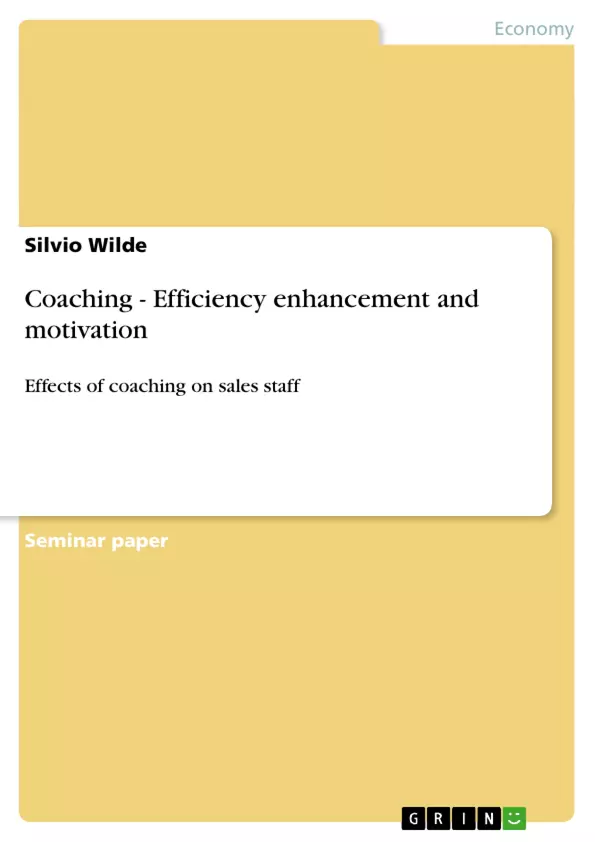1. Introduction
1.1 Focus of this scientific abstract
Today’s extremely competitive global market place requires a greater level of competences and skills of sales staff. Especially in times of financial crisis and a high degree of uncertainty, customers demand mutual trust and sales professionals. They expect to receive individualized solutions to their problems and not as 30 years ago a nice smile and a warm welcome. As this relies on all service industries, we defined the financial sector as the focus of our scientific abstract, in order to narrow the mass down and to create a comparable basis.
The over 200 identified competencies in over 30 categories that are required for an efficient selling, explain the complexity of the selling process . Therefore, the need of implementing a human resource development program is quite obvious. The question of the right approach to this problem will be specified by the following hypothesis:
Coaching - Efficiency enhancement and motivation? - Effects of coaching on sales staff
In the course of this scientific abstract we are going to examine this hypothesis by referring both to the theory and the practice, represented by Atradius AG and Commerzbank AG. Atradius is the second largest credit insurance company in the world, therefore mostly a global player. Commerzbank is the leading German universal bank with the focus on small and medium sized enterprises (SMEs) and private customers. Both are eminent organizations of the financial sector and highly dependent on the quality and profitability of their sales staff.
1.2 General definition of coaching
Although there is no single agreed upon the definition of the term ‘coaching’, numerous [...]
Inhaltsverzeichnis (Table of Contents)
- Introduction
- Focus of this scientific abstract
- General definition of coaching
- Differentiation coaching vs. training
- Concepts of coaching
- Aims and expectations of sales staff coaching
- Concepts and models
- Phases of coaching process
- Theory of sales staff coaching process
- Sales staff coaching at Commerzbank
- Sales staff coaching at Atradius
- Critical analysis
- Preface
- Success factors of sales staff coaching
- Possible benefits of sales staff coaching
- Possible drawbacks of sales staff coaching
- Relevance of sales staff coaching for practice
- Conclusion
- Coaching - Efficiency enhancement and motivation!
- Résumé
Zielsetzung und Themenschwerpunkte (Objectives and Key Themes)
This scientific abstract explores the impact of coaching on sales staff efficiency and motivation in the context of a competitive global market. The primary aim is to analyze the effectiveness of coaching programs in enhancing sales staff performance within the financial sector, specifically focusing on the cases of Commerzbank AG and Atradius AG.- Defining and contrasting the concepts of coaching and training
- Examining the aims and expectations of sales staff coaching programs
- Analyzing the key success factors and potential benefits of sales staff coaching
- Evaluating the potential drawbacks and limitations of sales staff coaching programs
- Assessing the practical relevance of sales staff coaching in today's market
Zusammenfassung der Kapitel (Chapter Summaries)
The first chapter sets the stage for the research, introducing the need for enhanced sales staff competencies and skills in today's competitive global market. It defines coaching as a distinct human resource development instrument and outlines its key differences from traditional training methods. Chapter two delves into the specific aims and expectations of sales staff coaching programs, exploring established concepts and models relevant to the topic. It also provides a theoretical framework for understanding the phases of the coaching process.
Chapter three further investigates the implementation of sales staff coaching programs within two prominent financial institutions, Commerzbank AG and Atradius AG. The chapter presents a detailed analysis of their respective coaching approaches, providing valuable practical insights. Chapter four embarks on a critical analysis of the topic, identifying key success factors, potential benefits, and possible drawbacks of sales staff coaching programs. It also explores the relevance of these programs for practical application within the financial sector.
Schlüsselwörter (Keywords)
This scientific abstract delves into the realm of human resource development and sales performance within the financial sector. It explores the role of coaching as a tool for enhancing staff efficiency and motivation, focusing on the key concepts of coaching versus training, individual development, and the practical application of coaching programs within organizations like Commerzbank AG and Atradius AG.- Citar trabajo
- Silvio Wilde (Autor), 2009, Coaching - Efficiency enhancement and motivation, Múnich, GRIN Verlag, https://www.grin.com/document/133693



